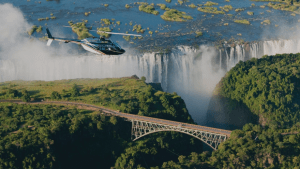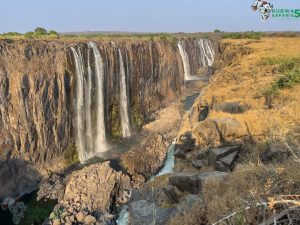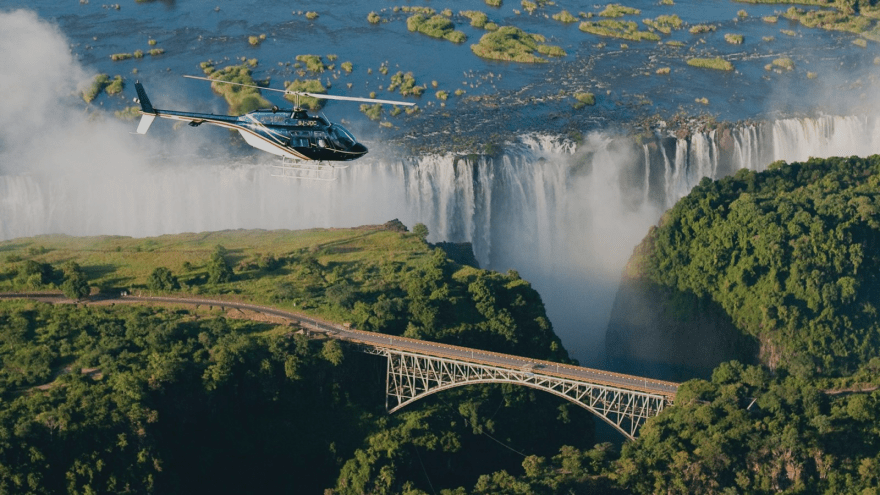Table of Contents
Top 4 Best Waterfalls In Namibia

Namibia is a natural blessed country and this blog details the major top 4 best waterfalls in Namibia and they include; Ruacana falls, Tufa falls, Popa falls among others. Namibia is a country in the Southern Africa bordered by Angola in the North, Botswana and South Africa in the East. Namibia is one of the leading tourism destinations in Southern African and its main attractions are Deadvlei, Sosussveil , Etosha National Park among others.
The following are the top 4 best waterfalls in Namibia;
Epupa Falls
The name Epupa is a Herero word to mean foam in reference to the foam created by the falling water. The Epupa Constituency is named for the falls. The falls are locus of many different number of Fish and other aquatic species .This is due to its specialized steep nature where you can ask your self on how to get to the falls.
The falls are also known as Monte Negro falls in Angola which is a series of large waterfalls formed by the Cunene River on the border of Angola and Namibia, in the Kaokoland area of the Kunene Region. The river is about 0.5 kilometers (1,600 ft.) wide in this area and drops in a series of waterfalls across a length of 1.5 kilometers (0.93 mi), with the greatest single drop being 37 meters (121 ft) in height
The falls are a major visitor attraction in Namibia due to their largely unspoiled environment consisting of fig trees, baobabs, makalani palms and colorful rock walls framing the falls and they can be reached via Opuwo though the access is a bit difficult. You will need a four wheel drive to reach the falls.
Activities in the area range from guided tours to the falls and Himba villages around the falls, bird watching, excursions to see crocodiles, and a variety of vegetation featuring trees like baobab and Mopane trees, the dominant species in the area. Tourists are also offered white water rafting at Epupa Camp.
The falls are also known for the semi-nomadic Ovahimba people who live there, as well as other tribes like the Ovatjimba, Ovazemba, and Ovatwa people. Migration to the falls is constantly increasing due to high tourism growth, which encourages tribes of Herero- and Ovambo-speaking peoples to move to the area.
The falls are featured in the 8th episode of the first season of the grand tour being the termination point of a journey in beach buggies through Namibia. Visit the falls and experience a fulfilling African safari. The falls have world class accommodation so all you need to do is book a date and be pampered the African way.
Incase you are wondering on how to get to Epupa falls, its via Opuwo town in Kenene region on the C43 thou its advisable to get enough fuel and essentials since its a scarce place. For all those wondering where to sleep, The Epupa falls accommodations are available for tourists and they range from budget, midrange and luxury accommodation. The various Epupa falls lodges around the falls will give you a well deserved rest in the wilderness.
Victoria Falls
These are among the top 4 best waterfalls in Namibia. The falls is a paradox of tranquil beauty and exciting adventure. The Smoke that thunders is undoubtedly Namibia’s finest and most well-known attraction. It is one of the seven world wonders and considered to be one of the world’s largest waterfalls. It’s not the widest or the highest, yet it is considered to be the largest based on it’s combined width at 1,708 meters wide and height at 108 meters. Impressively it takes the title for the largest sheet of falling water.


The water levels depict your experience of the falls. High waters usually peak in April which means you’re bound to get wet. You may not even actually see the falls from up close as the water comes crashing down. You certainly won’t see the foot of the falls, but it’s quite a good experience the experience.
As the water levels drop the spray and the falls become more visible with rock face showing. The lowest water flow is experienced around November. An entirely different experience as the falls see around a tenth of the volume of water. The question is not whether to go, but rather when to go.
Activities abound and they span the gamut of experiences from serene nature, like bird hides, nature walks and restorative spas, to wild action, like white water rifting, bungee jumping and high wires. The rickety railings at the sheer precipice are excitement enough for some. Others take it to the extreme, swimming in a whirlpool at the falls’ edge commonly done from the Zambian side. Either way the falls will enthrall you with its might and multitude of picturesque vantage points.
Scenic flights over the falls, dubbed the “Flight of Angels” after Livingstone’s famous words, offer a staggering perspective of this mile-wide phenomenon. A must do activity A new perspective of the falls in their sheer glory.
Along the Zambezi River and surrounding the powerful falls is a National Park and there are several excellent game reserves nearby making an incredible wildlife safari combination a popular option. The art and craft markets have equal shares of vibrant colors and vibrant traders such as museums with some are exhibiting in their own right and offer a sober look at the natural and political history of this significant region.
Most of the hotels have excellent restaurants and themed bars some of which extend to casinos and cabaret shows. For a hint of local and authentic culture, a dinner at the Booma restaurant is a given. Have your face painted, play drums and try Mopane worms if you’re up for the challenge. Not everyone does so if you do, you’ll get a certificate to prove your exotic cuisine preferences or rather your bravery.
There are a number of activities to do at the falls like horse riding, mountain biking, fishing, skydiving, abseiling, tennis, squash and more. Make sure create time to visit the falls and embrace the mother nature gifts.
Ruacana Falls
Ruacana Falls is a waterfall located in Ruacana, Omusati on the Kunene River in the Northern part of Namibia. The Kunene river forms part of the border between Namibia and Angola and plunges into a 120 meters deep and 700 meters wide gorge which forms the Ruacana Falls.
It is among the top 4 best waterfalls in Namibia and also some of the largest waterfalls in Africa, both by volume and width and the sound the waterfall makes is strange and unique to find any where in Africa hence giving the tourist an exciting and excellent experience. While there different activities can be engaged into such as hiking to the top of the falls, bird watching , nature walk and photography
Popa Falls
Popa Falls are one of the top 4 best waterfalls in Namibia and are located in the north eastern corner of Namibia. The falls are in fact a series of cascades created by a quartet ledge that cause the Okavango river to split into numerous channels with the main view point being at Popa Falls.
The falls are located on the Okavango river which is the fourth longest river system in the southern Africa with 1600 kilometers. The river originates from Angola where its called the Cubango. Popa falls has a rating of 3.49 among the top a hundred attractions in Namibia.
The falls are surrounded by Indigenous woodlands, river rine forests, floodplains and reed lined channels. There is also a game park know as Popa falls game park which is the smallest game park in Namibia with over 450 species of birds recorded, wide variety of wildlife species including elephant, hippo, water buffalo, crocodile, red lachwe, reed buck, roan and sable antelope even the elusive Sitatunga antelope can be observed.
The river also has an abundant fish species such as Tiger fish, threes pot, brims, kabeljou and green headed tilapia which are just some of the species of game fish that occur in the Kavango river making it a popular destination for anglers.
The falls can facilitate your stay with different accommodation facilities for both budget and high income customers ranging from hotels, lodges ,motels and camping sites and these include;
Other Attractions in Namibia
Deadvlei and Sossusvlei


Two of Namibia’s visual wonders are located in the Namib Naukluft Park in the midst of the Namib Desert that is the Sossusvlei and Dead Vlei. The Namib Naukluft Park is the largest protected area in the nation, this conservation area is located within the Namib, the oldest desert in the world.
It is situated along the Atlantic coast and spans over 50,000 km2. Namib, Naukluft, Sossusvlei/Sesriem, and Sandwich Harbour were combined to establish the park. The park’s current dimensions were declared in 1979. The Naukluft Mountains, the Sossusvlei, and a portion of the Kuiseb River are the only areas of the park that are open to visitors. The vast protected region is between 100 and 500 kilometers long.
Namib National Park: Namib National Park is comprised of; the desert of Namib, the mountains of Naukluft, Sandwich Harbour, Sossusvlei, Dead Vlei and Sesriem. Few areas in the Namib can be visited and these include the region north of the Kuiseb River, the Naukluft Mountains, and the Sossusvlei can be visited out of the enormous area of dune fields that span 32,000 km2.
The Namib Naukluft Park has been a part of the Namib Skeleton Coast National Park since 2010, which is the eighth-largest protected area in the world and the largest in Namibia. The Skeleton Coast Park, the Namib Naukluft Park, the Restricted Diamond Area, the Dorob National Park, the Fish River Canon, and the marine preserve Meob-Chamais were all combined to create this park. With a length of 1570 km, Namibia’s newly created Namib Skeleton Coast National Park runs the whole length of its Atlantic coast, from the country’s northern border with Angola to its southern border with South Africa.
Etosha National Park: The huge, salty Etosha Pan is what makes Etosha Namibia’s most well-known park for wildlife viewing. The waterholes near the pan fill up with dense populations of animals throughout the dry season. Only buffalo is missing from the Big Five, which totals four animals. The floodlit waterholes in Etosha offer a rare chance to see wildlife at night.
The Kalahari Desert in Namibia: Over 900,000 km2 of southern Africa, including sections of Botswana, Namibia, and South Africa, are covered by the huge semi-arid Kalahari Desert. The Namib Desert and Namibia’s portion of the Kalahari Desert meet in the eastern and southern regions of the nation. After the Sahara, the Kalahari Desert is the largest desert in Africa. This African desert was created more than 60 million years ago when the Gondwana supercontinent split apart, which led to a drier environment.
The Kalahari Desert is not a true desert, despite its Tswana name, which translates to “the great thirst,” because it receives a little bit more rainfall than the average desert. But because of the intense heat, the water either evaporates or dips beneath the sand.
Okonjima Game Reserve: In Namibia, the Okonjima Game Reserve is tucked between Etosha National Park and Windhoek. The reserve, which can be reached by both road and air transfers, is well-known for its cheetah and leopard population.The AfriCAT Foundation, a fantastic rehabilitation facility that spearheads initiatives to release abused cheetah, wild dog, hyena, and leopard back into the wild, is based in the Okonjima Game Reserve. Incredibly diverse animals can also be viewed on exhilarating game drives through the Okonjima Game Reserve.
Accommodations are available in game lodges and bush camps in the Okonjima Game Reserve. Game drives, trips to AfriCAT, bush walking trails, bird watching, and many more activities are available in Okonjima.
Namibia is a destination that you can visit throughout the entire year thou incase you want to do a safari, the best months to visit is between May to October during the dry season when the animals are closer to the water source.

